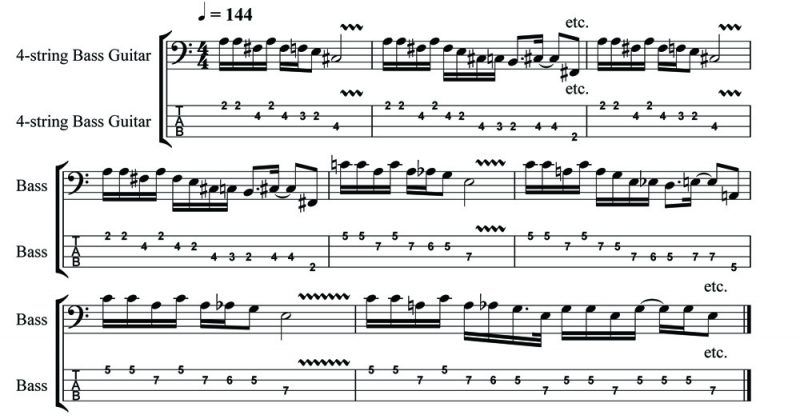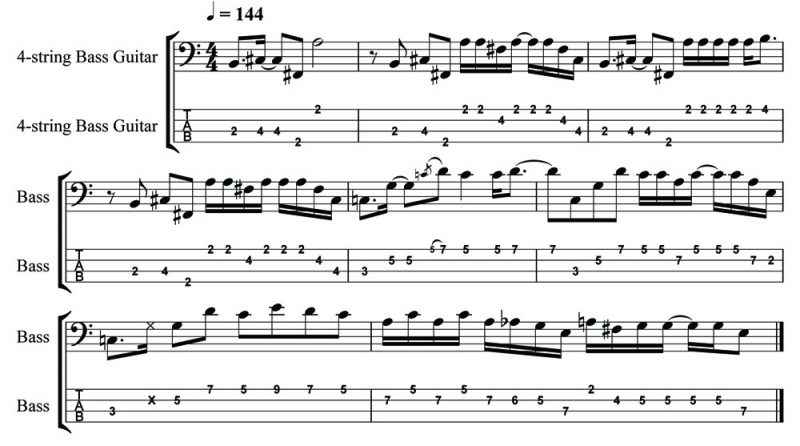Deep Thinking: YYZ: The Prog Rock of Rush continued…
Deep Thinking: YYZ: The Prog Rock of Rush continued…
After the tricky introduction that we looked at in the last issue of NZM, we are now in a relatively easier section of the Rush track YYZ, but it’s still quite fast.
The easiest way to build up hand speed is to practice slowly with a tempo keeping device (you can easily download one) and keep a daily record of your practice tempos. If you gradually increase tempo over a period of days, or weeks, you will find that, rather than trying to hold a tempo you cannot manage, you will have developed strength in your hands that enables you to play fast passages when required.
Example 1 is the section immediately after the introduction. It is mainly pentatonic with a chromatic passing note in each bar. Place fretting finger one on the A at fret 2, string 1 and every note that follows is under the remaining fingers. The wiggly lines over certain bars mean a slight string bend.
The low F# at the end of bar two is also played by fretting finger one. Bars three and four are the same as bars one and two. Bar five is the same figure as in bar one, but you need to move your fretting hand up a minor third so that fretting finger one is on C at fret 5, string 1. Bar six is the same as bar two, but also in the new position, and bar seven is also the same as bar five. The final bar in this example has a demisemiquaver in the middle as a skip onto the second half of the bar. It has a slightly different rhythm but still repeats the pentatonic notes of the phrase.
Example 2 is a variation of what precedes it. It is what is known as an inversion – the phrase is almost turned upside down. Starting on B at fret 2, string 3, the phrase moves up to C# at fret 4 before F# at fret 2, string 4, and then finally moves to the A at fret 2, string 1, thus restating the root note. It is still pentatonic.
Bar two has a quaver rest to introduce space into the pattern but it still has the same notes, just more of them. (It’s prog don’t forget!) There are slight rhythmic variations in bars three and four but they are almost the same as the earlier bars –– check the track on YouTube. Bar five changes the fretting hand position, as in the first example.
The riff moves up to C at fret 3, string 3, up a fifth to G at fret 5, string 2, followed by a semiquaver push and then a very quick slide from C to D on string 1. This note is tied to the D in bar six. The phrase is a simple root, fifth, ninth (the upper D), so maybe use fingers one, three and four for this.
Bar seven is very similar except for the dead note played at the G position. The final bar combines the A and C based phrases, again with a chromatic passing note –– Ab –– giving the sound a slightly bluesy feel. Play this slowly and make sure you keep a constant tempo. Don’t rush the easier parts and slow down for the tricky parts.
Geddy Lee is the band’s vocalist and keyboard player, and also uses bass pedals to fatten up the low end. If you watch Rush In Rio, you’ll be amazed at how big a sound is created by the three musicians. Lee uses Fender and Wal basses, but his choice of amplification seems to be three large industrial washing machines. (Check the Rio stuff on YouTube and you will see what I mean.)
Dr. Rob Burns is an Associate Professor in Music at the University of Otago in Dunedin. As a former professional studio bassist in the UK, he performed and recorded with David Gilmour, Pete Townsend, Jerry Donahue, Isaac Hayes, Sam and Dave, James Burton, Ian Paice and Jon Lord, Eric Burdon and members of Abba. He played on the soundtracks on many UK television shows, such as Red Dwarf, Blackadder, Not the Nine OClock News and Alas Smith and Jones. Rob is currently a member of Dunedin bands Subject2change and The Verlaines.


